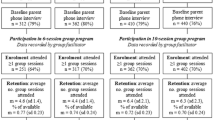Abstract
This paper reports findings on parental engagement in a community-based parent training intervention. As part of a randomized trial, 821 parents were offered group-based Triple P as a parenting skills prevention program. Program implementation was conducted by practitioners. The intervention was implemented between Waves 1 and 2 of a longitudinal study, with a participation rate of 69% and a retention rate of 96%. The study finds that a practitioner-led dissemination can achieve recruitment and completion rates that are similar to those reported in researcher-led trials. Second, the study found that different factors are associated with the various stages of the parental engagement process. Family-related organizational and timing obstacles to participation primarily influence the initial stages of parental involvement. The strength of neighborhood networks plays a considerable role at the participation and completion stages of parental engagement. The general course climate and the intensity of program exposure predict the utilization of the program several months after the delivery.

Similar content being viewed by others
References
Baydar, N., Reid, M. J., & Webster-Stratton, C. (2003). The role of mental health factors and program engagement in the effectiveness of a preventive parenting program for Head Start mothers. Child Development, 74(5), 1433–1453.
Cohen, D., & Linton, K. (1995). Parent participation in an adolescent drug abuse prevention program. Journal of Drug Education, 25(2), 159–169.
Dane, A. V., & Schneider, B. H. (1998). Program integrity in primary and early secondary prevention: Are implementation effects out of control. Clinical Psychology Review, 18(1), 23–45.
Domitrovich, C. E., & Greenberg, M. T. (2000). The study of implementation: Current findings from effective programs that prevent mental disorders in school-aged children. Journal of Educational and Psychological Consultation, 11(2), 193–221.
Dumas, J., Nissley-Tsiopinis, J., & Moreland, A. (2007). From intent to enrollment, attendance, and participation in preventive parenting groups. Journal of Child and Family Studies, 16(1), 1–26.
Eisner, M., & Ribeaud, D. (2005). A randomised field experiment to prevent violence: The Zurich intervention and prevention project at schools, ZIPPS. European Journal of Crime. Criminal Law and Criminal Justice, 13(1), 27–43.
Eisner, M., & Ribeaud, D. (2007). Conducting a criminological survey in a culturally diverse context. European Journal of Criminology, 4(3), 271–298.
Farrington, D. P., & Loeber, R. (2000). Some benefits of dichotomization in psychiatric and criminological research. Criminal Behaviour and Mental Health, 10, 100–122.
Ganzeboom, H. B. G., & Treiman, D. J. (1996). Internationally comparable measures of occupational status for the 1988 International Standard Classification of Occupations. Social Science Research, 25(3), 201–235.
Greenberg, M. T., Kusché, C. A., & Mihalic, S. F. (1998). Blueprints for violence prevention, book ten: Promoting Alternative Thinking Strategies (PATHS). Boulder, CO: Center for the Study and prevention of Violence.
Gross, D., Julion, W., & Fogg, L. (2001). What motivates participation and dropout among low-income urban families of color in a prevention intervention? Family Relations, 50(3), 246–254.
Guo, G., & Zhao, H. (2000). Multilevel modeling for binary data. Annual Review of Sociology, 26(1), 441–462.
Haggerty, K. P., MacKenzie, E., Skinner, M., Harachi, T., & Catalano, R. (2006). Participation in “Parents Who Care”: Predicting program initiation and exposure in two different program formats. The Journal of Primary Prevention, 27(1), 47–65.
Harachi, T. W., Catalano, R. F., & Hawkins, D. J. (1997). Effective recruitment for parenting programs within ethnic minority communities. Child and Adolescent Social Work Journal, 14(1), 23–39.
Heinrichs, N., Bertram, H., Kuschel, A., & Hahlweg, K. (2005). Parent recruitment and retention in a universal prevention program for child behavior and emotional problems: Barriers to research and program participation. Prevention Science, 6, 275–286.
Kumpfer, K. L., Alvarado, R., Smith, P., & Bellamy, N. (2002). Cultural sensitivity and adaptation in family-based prevention interventions. Prevention Science, 3(3), 241–246.
Kusche, C. A., & Greenberg, M. T. (1994). The PATHS curriculum. Seattle, WA: Developmental Research and Programs.
McCurdy, K., & Daro, D. (2001). Parent involvement in family support programs: An integrated theory. Family Relations, 50(2), 113–121.
McTaggart, P., & Sanders, M. R. (2003). The transition to school project: Results from the classroom. Australian e-Journal for the Advancement of Mental Health, 2(3), 1–12.
Moncher, F. J., & Prinz, R. J. (1991). Treatment fidelity in outcome studies. Clinical Psychology Review, 11(3), 247–266.
Morawska, A., & Sanders, M. (2006). A review of parental engagement in parenting interventions and strategies to promote it. Journal of Children’s Services, 1(1), 29–40.
Mowbray, C. T., Holter, M. C., Teague, G. B., & Bybee, D. (2003). Fidelity criteria: Development, measurement, and validation. American Journal of Evaluation, 24(3), 315–340.
Myers, H. F., Alvy, K. T., Arrington, A., Richardson, M. A., Marigna, M., Huff, R., et al. (1992). The impact of a parent training program on inner-city African-American families. Journal of Community Psychology, 10(1), 132–147.
Reyno, S. M., & McGrath, P. J. (2006). Predictors of parent training efficacy for child externalizing behavior problems—A meta-analytic review. Journal of Child Psychology and Psychiatry, 47(1), 99–111.
Sanders, M. R. (1992). Every parent: A positive guide to children’s behavior. Sydney, Australia: Addison-Wesley.
Sanders, M. R. (1999). Triple P-Positive Parenting Program: Towards an empirically validated multilevel parenting and family support strategy for the prevention of behaviour and emotional problems in children. Clinical Child and Family Psychology Review, 2(2), 71–89.
Sanders, M. R., Markie-Dadds, C., & Turner, K. T. (2003). Theoretical, scientific and clinical foundations of the Triple P Positive Parenting Program: A population approach to the promotion of parenting competence. Parenting Research and Practice Monograph, 1, 1–21.
Shelton, K. K., Frick, P. J., & Wootton, J. (1996). Assessment of parenting practices in families of elementary school-age children. Journal of Clinical Child Psychology, 25, 317–329.
Snijders, T. A. B., & Bosker, R. J. (2004). Multilevel analysis: An introduction to basic and advanced multilevel modeling. London, UK: Sage.
Spoth, R. L., & Redmond, C. (1994). Effective recruitment of parents into family-focused prevention research: A comparison of two strategies. Psychology & Health, 9(5), 353–370.
Spoth, R. L., & Redmond, C. (2000). Research on family engagement in preventive interventions: Toward improved use of scientific findings in primary prevention practice. The Journal of Primary Prevention, 21(2), 267–284.
Spoth, R. L., Redmond, C., & Shin, C. (2000). Modeling factors influencing enrollment in family-focused preventive intervention research. Prevention Science, 1(4), 213–225.
Spoth, R. L., Clair, S., Greenberg, M. T., Redmond, C., & Chungyeol, S. (2007). Toward dissemination of evidence-based family interventions: Maintenance of community-based partnership recruitment results and associated factors. Journal of Family Psychology, 21(2), 137–146.
Tremblay, R. E., Loeber, R., Gagnon, C., Charlebois, P., Larivée, S., & LeBlanc, M. (1991). Disruptive boys with stable and unstable high fighting behavior patterns during junior elementary school. Journal of Abnormal Child Psychology, 19(3), 285–300.
Webster-Stratton, C., Reid, M. J., & Hammond, M. (2001). Preventing conduct problems, promoting social competence: A parent and teacher training partnership in Head Start. Journal of Clinical Child Psychology, 30(3), 283–302.
Acknowledgments
We would like to thank Denis Ribeaud, Tina Malti, Margit Averdijk, and Philippe Sulger for comments on earlier versions of this paper.
Author information
Authors and Affiliations
Corresponding author
Rights and permissions
About this article
Cite this article
Eisner, M., Meidert, U. Stages of Parental Engagement in a Universal Parent Training Program. J Primary Prevent 32, 83–93 (2011). https://doi.org/10.1007/s10935-011-0238-8
Published:
Issue Date:
DOI: https://doi.org/10.1007/s10935-011-0238-8




